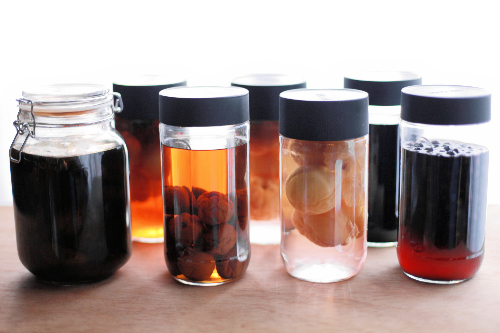
If I was to describe my summer this year in one word, it would be "fruits". Fresh fruits, of course (though that makes two words), and a lot of them (five words now?). Most of them, if not all, were grown locally here in Nagano, a beautiful, mountainous area in the heart of Japan.
June came with rhubarb and gooseberries. Then I spent the month of July busying myself with making the most of short seasons of apricots and cherries (though the latter was mostly imported Bings, I must admit). And come August peaches and blueberries effectively took over my days - when I wasn't picking, eating, or baking with them, I was thinking about how best to use them at their best.
And one way to preserve the best of the fresh fruits of the season, at least for me, was to make liqueurs with them. You see, I'm not really keen on jams and preserves, and canning generally involves more process (and sugar) than I'd ever like to have with my fruits.
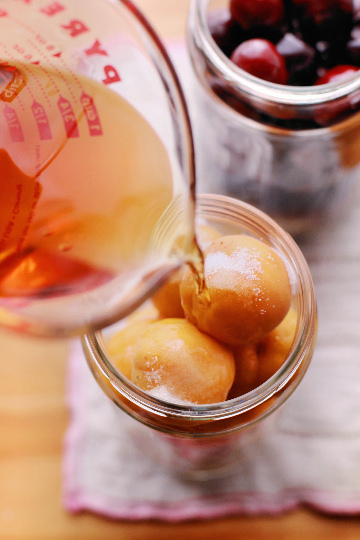
Homemade liqueurs are usually simple to make; all you need to do is, basically, to cut up your fruits (sometimes even that may be skipped), and throw them into a clean jar with some sugar and liquor. The only time-consuming part is, well, letting them stand - usually for months at least, sometimes years, shaking the jar every now and then, patiently waiting for them to develop the flavor.
And I'm not too bad at waiting. Truth be told, I tend to forget about it after a while; after the first few weeks of being keenly anxious to see how a particular batch of my liqueur would turn out, I'd calm down a bit and become able to handle it without being overexcited. Then before I know it, a few months would have passed - rather alarmingly so.
I had made homemade liqueurs from before, but never as intensively as I have done this summer. I don't label my jars of liqueurs properly like I should, but here I am making some notes so I'll remember what I did with them...
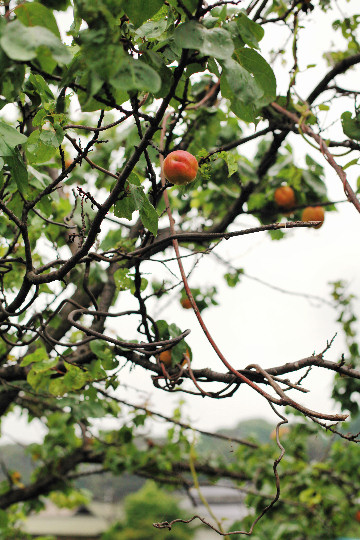
At the beginning of July, we went to pick apricots off the tree at my mother's friend in a neighboring town. I made quite a few things with them, as I have already rambled on about it - a lot of them together with cherries.
Even if I didn't really care for apricots, I did like apricot brandy (and cherry brandy, as well), so the idea of making my own appealed to me very much. I basically followed this recipe, but made only roughly a quarter of it, and used (very cheap) brandy rather than vodka.
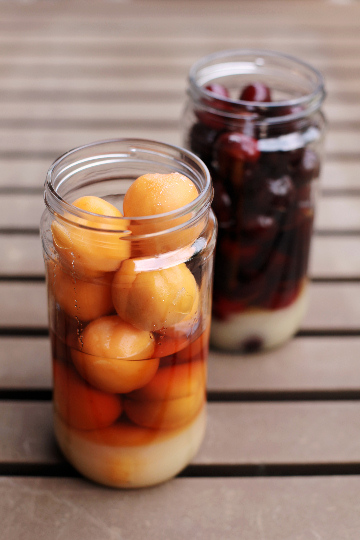
I filled a 1-liter (2-pint) jar with apricots (13-14 of them). There I added about 130-150 grams (10-12 Tbs) of granulated sugar and 300 ml (1 1/4 cups) of brandy. I did the same with Bing cherries. I started with a little less sugar and brandy than the quantity above, but couldn't help but adding a bit of liquid so more of the fruits would be submerged.
I flipped the jars upside down every day or so as the recipe tells you to, but once the fruits had shrunk and sunk to the bottom, I'd simply shake the jar a bit. I'd leave them to infuse for three months or so before bottling them, which will then be let stand for another few months or perhaps longer to mature.
And when we went over for apricots, there was a bonus:
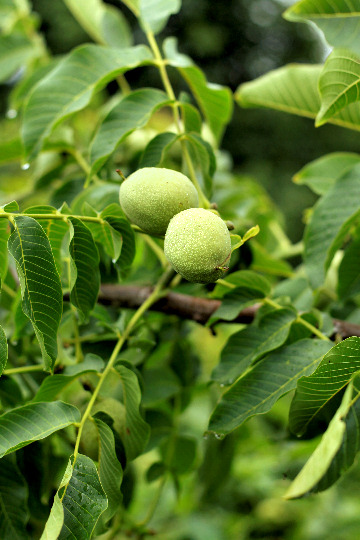
Green walnuts! Okay, they are not fruits, I know, but young and soft(er) walnuts would make some fabulous liqueur as I'd learned from David Lebovitz, first on his blog and then in his latest book Ready for Dessert: My Best Recipes (Ten Speed Press, 2010). Called nocino in Italy, it is a bitter and aromatic concoction made from green walnuts steeped in spirit (such as vodka) and flavored with spices.
Here I halved David's recipe and made my batch with 500 ml (a little over 1 pint) of vodka.
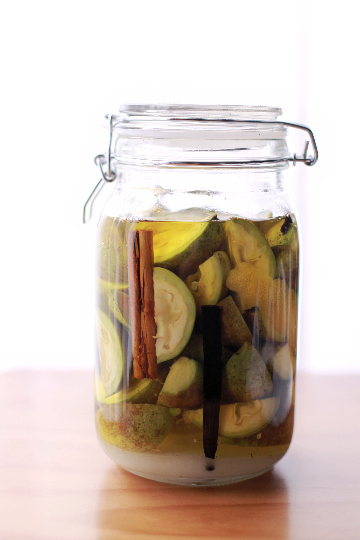
With it, poured into my jar were 15 green walnuts (quartered), 250 g (approx. 1 1/4 cup) of granulated sugar, a cinnamon stick, a few cloves, half a vanilla bean, and a few thick strips of lemon zest. Then it was left to stand for 4-6 weeks, with the jar shaken every day or so.
Almost as soon as everything had gone into the jar, the vodka started taking on a yellowish green shade, as you can see in the picture above. It looked a bit like olive oil, I thought to myself, and it was fun - although the real shock came the following day. You can see it how it looked like on the second day here - it was quite electric!
And August started with us picking peaches off of our tree...
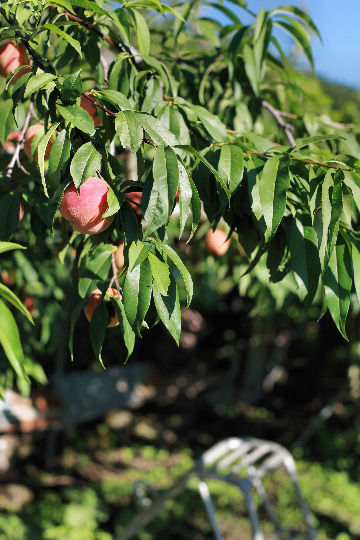
And peaches (white peaches, to be precise) are about my biggest favorite fruit of all, and yet I did not know, until earlier this summer, that my mother and their family had a peach tree here. Imagine my excitement (and a tiny bit of resentment - I mean, how could they not have told me about it before??).
I don't usually have any problem with eating fresh peaches as is, but when you have something like 50 pounds of them almost all at once, it does require you to be a little more creative. And while quite a lot of them were turned into frozen desserts, some did find their way into a jar with some strong alcohol...
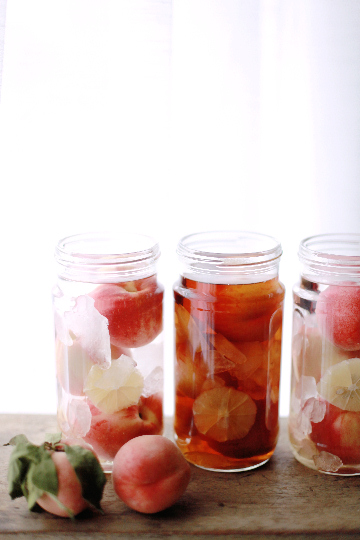
...Or three jars, in fact: vodka, brandy, and gin, all in the same preparation, just with different kinds of spirits. When I make fruit liqueurs at home, I tend to go for either vodka or brandy. I couldn't decide this time, and thought I'd try both - and then I remembered I'd liked the lychee liqueur I'd made (by accident) with gin last summer, so I decided to give it a shot, too. Might as well.
As with many other homemade fruit liqueurs, I found a variety of recipes for peach liqueur, some similar and others very different. In the end, I made my peach liqueurs based mostly on several different recipes for fruit liqueurs I'd found on the Internet, by throwing together 250-300 g of white peaches (more or less 10 ounces; 3 peaches), left whole and unpeeled (but well rinsed), 130-150 grams (give or take 5 ounces) of white rock sugar (or granulated sugar), and a lemon, peel removed and cut into thick slices, with 450-500 ml (more or less 1 pint) each of the three spirits.
Now I would leave them to infuse for two or three months, but a little surprise came early:
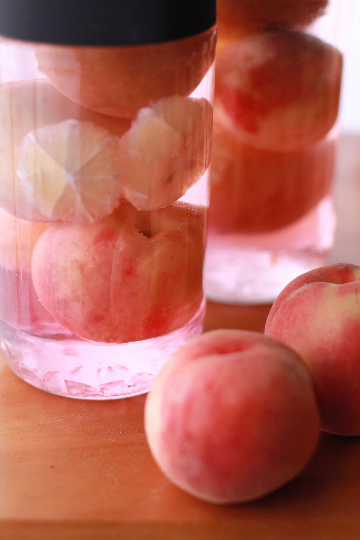
Quite early, in fact, for it was only the following morning when I woke up to find two of my three jars of peach liqueurs in the making to be in the prettiest shade of pink! And I knew it would fade to a pale amber sooner rather than later, which made appreciate the beauty even more. So for the following few weeks, I placed these bottles on our table and enjoyed looking at them.
And just when I thought our peaches left me no room for other fruits for the months, there were blueberries...
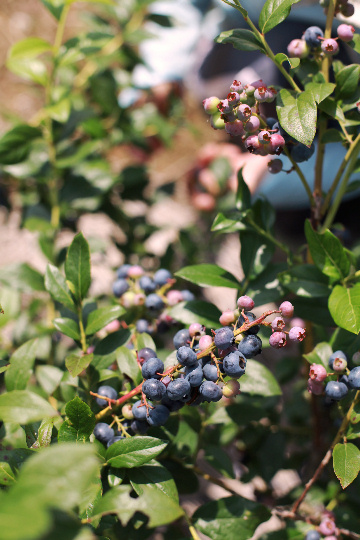
I was extremely lucky as my mom also knows someone who have a large blueberry patch, and they kindly invited us to come and pick their blueberries by ourselves. So we went. And we went again. (And almost went for the third time, but couldn't make it - though they instead picked a bunch for us.) Boy, I have never had so many blueberries in my life!
As blueberries freeze very well, storing isn't usually an issue. But I figured it wouldn't hurt if I, um, saved some in a liquor, which I did.
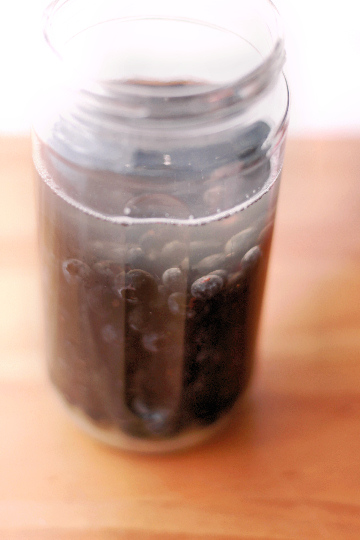
I used this recipe (called blueberry cordial, which I thought was nice) here, but when I made it I was a bit in a rush and literally threw things together. As a result, I managed to forget exactly how much of what went into my jar, but I think I halved the recipe and used 240 ml (1 cup) of vodka, 100 grams (1/2 cup) of granulated sugar and a little less than 200 grams (7 ounces or 1 1/2 cups) of fresh blueberries.
Like the peach liqueurs, this one also took on the color of the fruit almost immediately, and had turned deep purplish blue on the second day of steeping. This one was to be let stand for a couple of months.
So here are my babies from the summer:
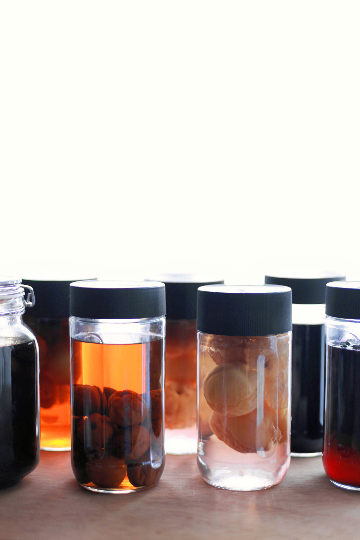
It is a very satisfying thing, let me tell you, to see these glass jars with different colors of liquid in them lining up in front of me - especially when they are all drinkable (or so they are meant to be!). In addition, my mother makes quite a lot of fruits liqueurs herself - she's been doing it for years - so the house is literally littered with jars of all kinds of liqueurs, small and large, young and aged.
Now some of you may have noticed, perhaps, that I made my liqueurs in relatively small quantities; nothing was made in, say, a gallon jar. This is mostly because what I was after was to try and taste homemade liqueurs made from fresh fruits, (mostly) from local farms (or even our own trees!) at the height of their season. Everything I made this summer was my first attempt of the kind, so I also wanted to see how they turn out first; if I liked them, maybe I can make it again in the next summer.
And, if I must be honest with you, I don't really drink any liqueur much, believe it or not - I enjoy them, I do, but I'm usually quite happy with just a few sips. So I really don't need that much of the stuff - although, I know my folks would be happy to, well, 'help' me finish them any day, so maybe I didn't have to worry about that.
While most of my liqueurs need to sit for some more time before bottling, one of them did become ready last weekend; I reckon you'd recognize this one?
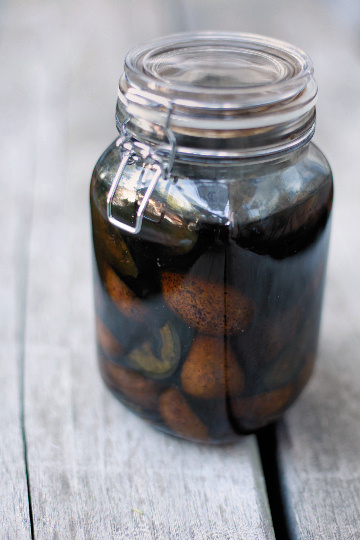
This is my nocino, all dark now with a hint of green. It had already looked pretty much like this as early as its second week into infusing, but quite a transformation nevertheless.
I took out the nuts and spices, then filtered the liquid through a coffee filter before bottling it in a few small bottles.
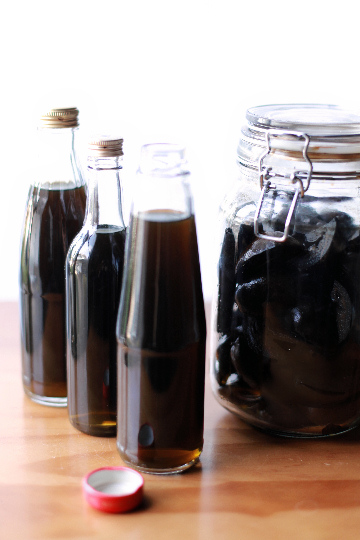
As I have never eaten green walnuts (can you at all?), I wasn't entirely sure how this liqueur would taste. I just imagined of something a little bitter but sweet, perhaps a bit mouth-puckering. And turned out, it was - only in a lot more deliciously so than I had expected it would be. It was definitely bitter, but not in an unpleasant way, and it was quite drinkable, though only in small sips. Perhaps because of the scents of spices and lemon, it somehow smelled of Christmas to me. We were sold.
We could have sipped our way through a bottle, but nocino is supposed to taste better as it sits longer, preferably for a year or more, allowed time to mature, as Elise suggested. So I have already stowed my bottles away, and am planning on opening one up maybe in the winter this year, but keeping the rest for later. I can't wait - but I sure will!
Then again, the waiting may be part of the fun in making your own fruits liqueurs, I suppose. But sometimes you wish you could just have a taste of it a little sooner - not in months, but in days? Well, I do! And there comes an excellent alternative to these time-is-the-secret-to-the-flavor homemade liqueurs:

How about brandying your fruits? These are brandied apricots and cherries as I have already written about, based on the recipe for brandied cherries included in Skye Gyngell's book My Favourite Ingredients (Quadrille Publishing, 2008). Here you heat together brandy, water and sugar and pour over fresh fruits to macerate for a week or so; they in essence are fruits in syrup, except the syrup is really boozy!
We enjoyed both apricots and cherries in brandy, so I tried it with peaches, too.
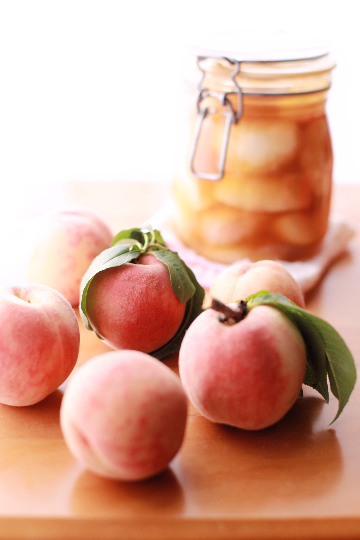
As with apricots and cherries, I ended up using a little more brandy than specified in the recipe; a little over 500 grams (about 18 ounces) of peeled, stoned, and quartered peaches, 250 ml (generous 1 cup) of brandy, 5 Tbs of granulated sugar, and 4 Tbs of water. Actually, I substituted the water with some of the juice from peaches that you'd inevitably have as you cut up your peaches, so the syrup got a little "cloudy".
The recipe tells you to leave the fruits in syrup at a "cool, dry place" for a week, then in the fridge. But it is extremely tricky to secure a cool, dry place that is not in the refrigerator in August in Japan, so I compromised a bit and put my jar in a place I thought was the coolest in the house just for 4-5 days, then moved it into the fridge; you could probably keep it in the fridge from the beginning, I reckon - just allow it a little longer a period of time.
The brandied peaches taste quite delightful, but the macerating syrup is good, too, on its own; it made a light, sweet drink on ice...
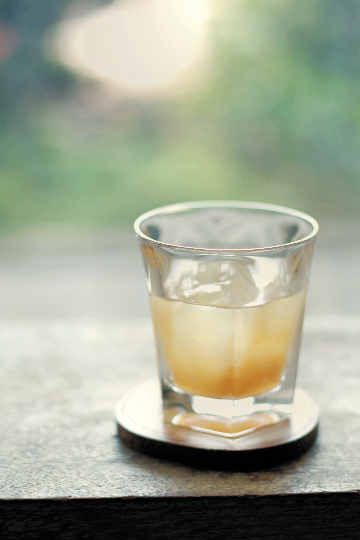
I should probably note that, although this made a perfect drink for me personally, it did taste a bit more dilute than our apricot and cherry 'brandies', possibly due to the higher content of water in peaches. You could probably reduce the water in the syrup a bit, or omit it, even.
Other than cherries, Skye Gyngell notes in her recipe that they may brandy raspberries and damsons; and I'm thinking doing it with prune plums once they are ripe. And brandied fruits should keep for a year refrigerated, she also adds, although the "brandy will eventually overwhelm the delicate flavour of the fruit".
So this is what I have been doing in an attempt to preserve a taste of summer, to be enjoyed later in the colder months...
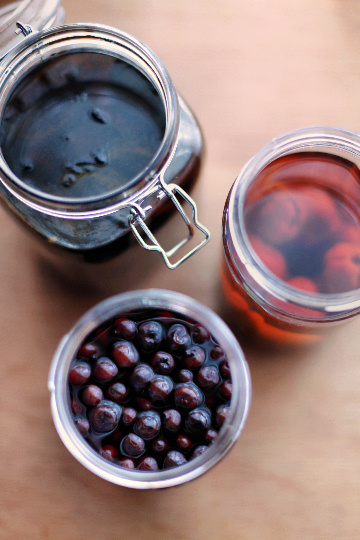
And I am thinking I'll try and make jam from the fruits in the liquor when the liqueurs are ready to bottle; I hear that fruits will often have lost much of their flavor and not suitable for snacking, but I know some people make jam, so I might try that.
For the record, I have done quite a few other things with these summer fruits; baking, making cold desserts, for the most part. And took pictures of most of them, even - from new york cheesecake with lemon thyme-scented rhubarb and strawberry compote and rhubarb and cherry crumble with mint and olive oil to gooseberry cordial with lemon thyme; and gooseberry and almond slices, and from blueberry-cornmeal mini cakes and sweet corn ice cream with blueberry compote and blueberry cheesecake, to peach-rose champagne sorbet and shortcake with peaches with lavender.
And yet, I have simply run out of time to blog about them - and I don't think it would be of much use if I did a post about them when the key ingredients (i.e. rhubarb, gooseberries, blueberries, and/or peaches) have already disappeared from the store shelves (or from the orchards). So hopefully I can revisit them in the next summer, in time for the fruits to come back for the year.
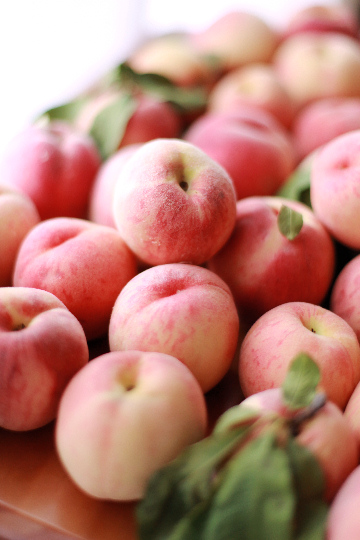
Meanwhile, I have set myself to eat the summer fruits as much as I can - and as long as I can. I did wonder, at one point, if I was eating too much of them. Then I realized, in shock, that in just a couple of months' time, there will be no fresh seasonal fruits for me to eat other than apples.
So excuse me while I hang on to peaches and nectarines when there already are pears and satsumas. I'm not sorry to see the summer go, but with the summer fruits, I am. Very, very much. And when it's finally cool and there is no fresh berries or stone fruits at the store, I will then start looking forward to opening up some of my jars of summer fruit liqueurs. And I've got the feeling that it will not be too far off.
p.s. I think I have to do this, too! - bachelor's jam

8 comments:
Beautiful photos as always. I'm amazed by how many of these liqueurs you made. Now, even in the depths of winter, you'll be able to savor a little taste of summer!
Wonderful post.
You can also try Shochu for your fruit liquer. I tried with lychee and it works very well.
those jars of liqueurs sure do look summery! and the bachelor's jam sounds really interesting. looking forward to your post on that! :)
I wish I was lucky enough to have fresh fruits in the garden, but a few berries is about all I can squeeze in there :(
They look beautiful as well as delicious. I've never tried making my own liqueurs although I my grandmother used to make ume-shu. I'm tempted now!
2yrs ago while i was in Japan, i bought some peaches from a street vendor who sold nothing but peaches in his small lorry..since then i fell in love with Japan peaches..
How i envy you! Here at home, its just too costly to buy the peaches that are import from Japan..
Oh how fun! Beautiful photos
hello all, thanks for your comments!
shichimi - yep that's what i'm after! can't wait for the winter!! ;)
Jodi - yeah that's what most folks do in Japan actually - using shochu for homemade liqueurs. love lychee liqueur too!
chika - i really wanted (and still want) to try the bachelor's jam, but i might be running late... well there's always next year!
Scott at Real Epicurean - yes i really think i've been extremely lucky to spend the summer in the mountains where the fresh fruits are abundant. not the same in tokyo!
chasingbawa - it's really simple and quite therapeutic to see your jars of liqueurs in the making! do give it a go!
Anonymous - yes i really do think japanese peaches are THE best!
Post a Comment